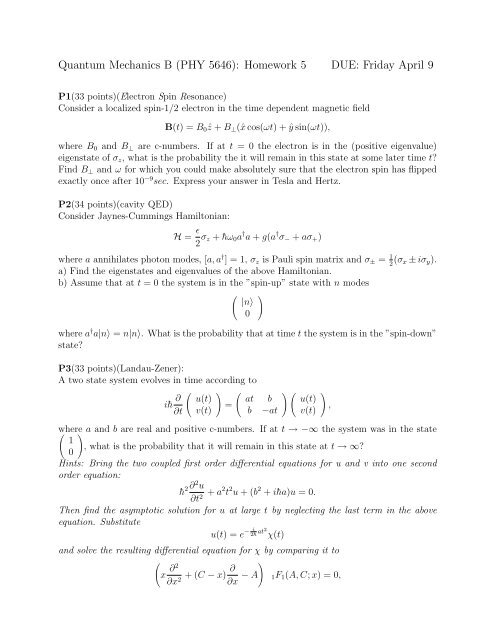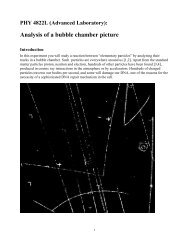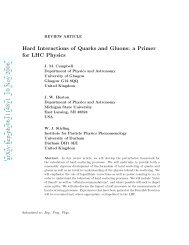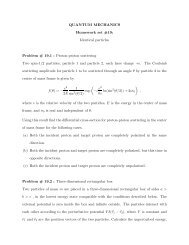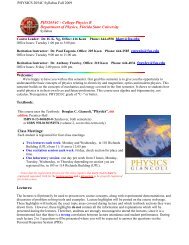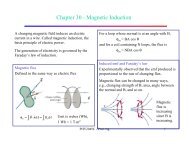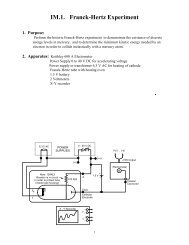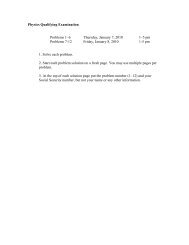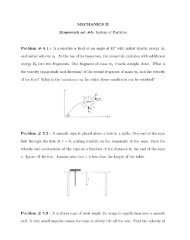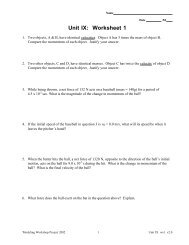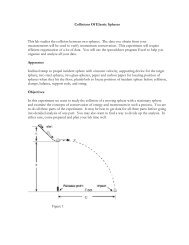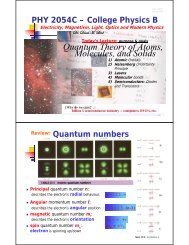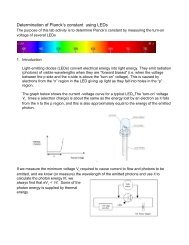Quantum Mechanics B (PHY 5646): Homework 5 DUE: Friday April 9
Quantum Mechanics B (PHY 5646): Homework 5 DUE: Friday April 9
Quantum Mechanics B (PHY 5646): Homework 5 DUE: Friday April 9
Create successful ePaper yourself
Turn your PDF publications into a flip-book with our unique Google optimized e-Paper software.
<strong>Quantum</strong> <strong>Mechanics</strong> B (<strong>PHY</strong> <strong>5646</strong>): <strong>Homework</strong> 5 <strong>DUE</strong>: <strong>Friday</strong> <strong>April</strong> 9P1(33 points)(Electron Spin Resonance)Consider a localized spin-1/2 electron in the time dependent magnetic fieldB(t) = B 0 ẑ + B ⊥ (ˆx cos(ωt) + ŷ sin(ωt)),where B 0 and B ⊥ are c-numbers. If at t = 0 the electron is in the (positive eigenvalue)eigenstate of σ z , what is the probability the it will remain in this state at some later time t?Find B ⊥ and ω for which you could make absolutely sure that the electron spin has flippedexactly once after 10 −9 sec. Express your answer in Tesla and Hertz.P2(34 points)(cavity QED)Consider Jaynes-Cummings Hamiltonian:H = ɛ 2 σ z + ¯hω 0 a † a + g(a † σ − + aσ + )where a annihilates photon modes, [a, a † ] = 1, σ z is Pauli spin matrix and σ ± = 1(σ 2 x ± iσ y ).a) Find the eigenstates and eigenvalues of the above Hamiltonian.b) Assume that at t = 0 the system is in the ”spin-up” state with n modes( )|n〉0where a † a|n〉 = n|n〉. What is the probability that at time t the system is in the ”spin-down”state?P3(33 points)(Landau-Zener):A two state system evolves in time according toi¯h ∂ ( ) (u(t) at b=∂t v(t) b −at) (u(t)v(t)),where ( ) a and b are real and positive c-numbers. If at t → −∞ the system was in the state1, what is the probability that it will remain in this state at t → ∞?0Hints: Bring the two coupled first order differential equations for u and v into one secondorder equation:¯h 2 ∂ 2 u∂t + 2 a2 t 2 u + (b 2 + i¯ha)u = 0.Then find the asymptotic solution for u at large t by neglecting the last term in the aboveequation. Substituteu(t) = e − i2¯h at2 χ(t)and solve the resulting differential equation for χ by comparing it to()x ∂2∂+ (C − x)∂x2 ∂x − A 1F 1 (A, C; x) = 0,
where 1 F 1 (A, C; x) is the confluent hypergeometric function. You will have to do some substitutionshere. Use this solution for u to construct v. Show that another orthogonal solutioncan be constructed by taking u → v ∗ and v → −u ∗ . Next, match the boundary conditions bydemanding that as t → −∞:α(u1 (t)v 1 (t))+ β(u2 (t)v 2 (t)) ( )1= .0To do so note that for any real t(u∗1 (t) v1(t)∗u ∗ 2(t) v2(t)∗) (u1 (t) u 2 (t)v 1 (t) v 2 (t))=(1 00 1).Finally, to find out the desired probability|αu 1 (t) + βu 2 (t)| 2use1F 1 (A, C, z) ∼Γ(C)Γ(C − A) |z|−A e iA π 2which holds when z is positive and purely imaginary.+Γ(C)Γ(A) |z|A−C e i(A−C) π 2 e z ;|z| → ∞


